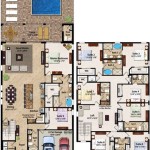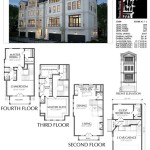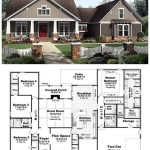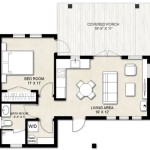3D house plan design is a digital architectural representation that allows designers and homeowners to visualize a home’s layout, exterior, and interior features. By creating a three-dimensional model, architects can provide a comprehensive and interactive representation of a building project. For example, potential homeowners can virtually walk through their future home, viewing rooms, windows, and even furniture placement, before construction begins.
These 3D designs offer an immersive experience, allowing stakeholders to make informed decisions about the design before it becomes a physical structure. The high level of detail and realism offered by 3D house plan design tools empowers designers to create accurate representations of building projects, improving communication between architects and homeowners, and enhancing the overall design process.
In this article, we will delve into the world of 3D house plan design, exploring its benefits, key components, and the process involved in creating these digital architectural representations. We will also showcase the latest trends and emerging technologies in the field, providing valuable insights for homeowners, architects, and anyone interested in the fascinating world of 3D house planning.
3D house plan design offers numerous benefits, including:
- Enhanced visualization
- Improved communication
- Accurate cost estimation
- Clash detection
- Virtual walkthroughs
- Realistic rendering
- Lighting analysis
- Energy efficiency
- Sustainability analysis
- Code compliance
These advantages make 3D house plan design an essential tool for architects, builders, and homeowners alike.
Enhanced visualization
3D house plan design provides an unparalleled level of visualization, allowing architects and homeowners to view a home’s design from any angle and perspective.
- Realistic 3D models: 3D house plan design software creates highly realistic 3D models that accurately represent the dimensions, materials, and finishes of a building. This allows stakeholders to visualize the home as it will appear in real life, making it easier to identify potential issues and make design decisions.
- Interactive walkthroughs: 3D house plan design tools enable users to virtually walk through their future home, exploring different rooms, layouts, and design options. This immersive experience provides a deeper understanding of the home’s flow and functionality.
- Detailed views: 3D house plans allow users to zoom in and examine specific details of the design, such as window styles, door hardware, and kitchen appliances. This level of detail helps ensure that every aspect of the home is carefully considered and meets the homeowner’s needs.
- Clash detection: 3D house plan design software can automatically detect clashes between different building elements, such as plumbing pipes and electrical wires. This helps architects identify and resolve potential construction issues early in the design process, saving time and money.
Overall, the enhanced visualization capabilities of 3D house plan design streamline communication, improve decision-making, and reduce the risk of costly errors during construction.
Improved communication
3D house plan design significantly improves communication between architects, builders, and homeowners by providing a shared visual representation of the project.
- Clearer understanding: 3D house plans provide a more intuitive and comprehensive representation of a home’s design compared to traditional 2D blueprints. This clarity reduces misunderstandings and ensures that all parties involved have a shared understanding of the project.
- Reduced errors: 3D house plans help identify and resolve potential issues early in the design process, minimizing the risk of costly errors during construction. By visualizing the design in three dimensions, architects and builders can proactively address any clashes or conflicts between different building elements.
- Enhanced collaboration: 3D house plans facilitate collaboration between architects, builders, and homeowners. The interactive nature of these plans allows stakeholders to provide feedback and make changes in real time, streamlining the design process.
- Improved client satisfaction: By providing clients with realistic and interactive visualizations of their future home, architects can better manage expectations and increase client satisfaction. 3D house plans empower homeowners to visualize their dream home and make informed decisions about the design, materials, and finishes.
Overall, improved communication fostered by 3D house plan design leads to a smoother design process, reduced errors, enhanced collaboration, and increased client satisfaction.
Accurate cost estimation
3D house plan design software provides accurate cost estimation by generating detailed material lists and construction estimates based on the 3D model. This helps architects and contractors determine the project’s cost more precisely, reducing the risk of budget overruns and unexpected expenses.
The software takes into account various factors that influence construction costs, such as the size and complexity of the home, the materials used, and the local labor rates. By analyzing the 3D model, the software can calculate the quantities of materials required, such as lumber, drywall, and roofing, and provide accurate cost estimates for each item.
Additionally, 3D house plan design software can generate interactive reports that break down the cost estimates into different categories, such as materials, labor, and subcontractors. This detailed breakdown allows architects and contractors to identify areas where costs can be optimized and make informed decisions about the project’s budget.
Overall, the accurate cost estimation capabilities of 3D house plan design software help architects and contractors plan and manage their projects more effectively, ensuring that they stay within budget and deliver high-quality homes to their clients.
Clash detection
Clash detection is a critical aspect of 3D house plan design that helps architects and builders identify and resolve potential conflicts between different building elements before construction begins. By analyzing the 3D model, clash detection software can automatically detect clashes between objects such as plumbing pipes, electrical wires, ductwork, and structural components.
Clash detection is essential for ensuring the safety and functionality of a building. By identifying and resolving clashes early in the design process, architects and builders can avoid costly delays and rework during construction. It also helps to improve the coordination between different trades, ensuring that all building systems are installed correctly and without interference.
The clash detection process typically involves importing all relevant building elements into the 3D model, including architectural, structural, mechanical, electrical, and plumbing (MEP) systems. The software then analyzes the model and identifies any overlaps or conflicts between the elements. Clashes are typically represented visually in the 3D model, making it easy for architects and builders to identify and resolve them.
Clash detection software can also generate reports that summarize the detected clashes and provide detailed information about the elements involved. This information can be used by architects and builders to prioritize the resolution of clashes and make informed decisions about the design.
Overall, clash detection is a valuable tool that helps architects and builders design and construct buildings that are safe, functional, and efficient.
Virtual walkthroughs
Virtual walkthroughs are an immersive and interactive feature of 3D house plan design that allows users to virtually explore a home before it is built.
- Realistic visualization: Virtual walkthroughs provide a highly realistic and immersive experience, allowing users to navigate through a 3D model of the home as if they were actually walking through it. This helps users visualize the home’s layout, space, and flow, and to make informed decisions about the design.
- Design validation: Virtual walkthroughs can be used to validate the design of a home before construction begins. By virtually walking through the home, users can identify potential issues with the layout, functionality, or aesthetics of the home, and make changes accordingly. This helps to avoid costly mistakes and ensures that the home meets the needs and expectations of the homeowner.
- Improved communication: Virtual walkthroughs can be shared with clients, contractors, and other stakeholders to improve communication and collaboration. By providing a shared visual representation of the home, virtual walkthroughs help to ensure that everyone involved in the project has a clear understanding of the design and can provide feedback and input.
- Marketing and sales: Virtual walkthroughs can be used as a powerful marketing and sales tool to showcase homes to potential buyers. By providing an immersive and interactive experience, virtual walkthroughs can help to generate interest in a home and make it more appealing to buyers.
Overall, virtual walkthroughs are a valuable tool that can be used at various stages of the design and construction process to improve visualization, validation, communication, and marketing.
Realistic rendering
Realistic rendering is a technique used in 3D house plan design to create highly detailed and photorealistic images of a home’s exterior and interior.
- Accurate materials and textures: Realistic rendering software can simulate the appearance of various materials and textures used in home construction, such as wood, brick, glass, and metal. This allows architects and homeowners to visualize the home’s finishes and make informed decisions about the materials and textures they want to use.
- Natural lighting and shadows: Realistic rendering takes into account the natural lighting conditions of the site, including the sun’s position and intensity at different times of the day. This allows architects to design homes that are optimized for natural lighting and to minimize energy consumption.
- Furniture and decor: Realistic rendering can include furniture, decor, and landscaping to provide a complete and immersive visualization of the home. This helps homeowners to envision how the home will look and feel once it is furnished and decorated.
- Interactive walkthroughs: Realistic rendering can be integrated with virtual walkthroughs, allowing users to navigate through a photorealistic model of the home and experience it from different perspectives.
Overall, realistic rendering is a powerful tool that can be used to create highly detailed and immersive visualizations of homes, helping architects and homeowners to make informed decisions about the design and construction process.
Lighting analysis
Lighting analysis is a crucial aspect of 3D house plan design that involves simulating and analyzing the natural and artificial lighting conditions within a home.
By using specialized software, architects can assess the amount and quality of light in different areas of the home at various times of the day and year. This analysis helps to ensure that the home is well-lit, comfortable, and energy-efficient.
Lighting analysis considers factors such as the size and orientation of windows, the reflectivity of surfaces, and the placement of light fixtures. By optimizing the natural lighting in a home, architects can reduce the need for artificial lighting, resulting in energy savings and a more sustainable design.
Additionally, lighting analysis can help architects to create specific lighting effects and moods within a home. For example, they can design spaces with ample natural light for tasks that require good visibility, such as reading or cooking, while creating more subdued lighting in areas intended for relaxation or sleep.
Overall, lighting analysis is a valuable tool that helps architects to design homes that are not only aesthetically pleasing but also functional and energy-efficient.
Energy efficiency
3D house plan design plays a crucial role in promoting energy efficiency in buildings. By simulating and analyzing the energy performance of a home’s design, architects can identify opportunities to reduce energy consumption and create more sustainable living spaces.
- Optimized building envelope: The building envelope, which includes the walls, roof, and windows, is a major factor in determining a home’s energy efficiency. 3D house plan design software allows architects to optimize the building envelope by analyzing the orientation of the home, the size and placement of windows, and the thermal performance of different materials. By designing a well-insulated and airtight building envelope, architects can significantly reduce heat loss and gain, leading to lower energy consumption for heating and cooling.
- Efficient lighting design: Lighting accounts for a significant portion of a home’s energy use. 3D house plan design software can be used to simulate natural lighting conditions and optimize the placement of windows to maximize daylighting. Additionally, architects can design efficient artificial lighting systems by selecting energy-efficient fixtures and controls, reducing the need for excessive lighting.
- Passive solar design: Passive solar design techniques harness the sun’s energy to heat and cool a home naturally. 3D house plan design software allows architects to analyze the sun’s path and design homes that maximize solar gain in winter and minimize it in summer. This can be achieved through the use of strategically placed windows, thermal mass, and overhangs.
- Renewable energy integration: 3D house plan design can facilitate the integration of renewable energy systems, such as solar panels and geothermal heat pumps, into the home’s design. By analyzing the energy needs of the home and the potential for renewable energy generation on the site, architects can design homes that are partially or fully powered by renewable energy sources, reducing reliance on fossil fuels and lowering energy costs.
Overall, 3D house plan design is a powerful tool that can help architects create energy-efficient homes that are comfortable, sustainable, and cost-effective to operate.
Sustainability analysis
Sustainability analysis is an integral part of 3D house plan design, enabling architects to assess the environmental impact of their designs and make informed decisions to minimize the ecological footprint of buildings.
- Material selection: The choice of building materials has a significant impact on a home’s sustainability. 3D house plan design software allows architects to evaluate the environmental performance of different materials, such as their embodied energy, recycled content, and end-of-life disposal options. By selecting sustainable materials, architects can reduce the environmental impact of the home throughout its lifecycle.
- Water conservation: Water conservation is essential for sustainable living. 3D house plan design software can be used to analyze water usage patterns and identify opportunities for water conservation. Architects can design homes with water-efficient fixtures, appliances, and landscaping to reduce water consumption and protect precious water resources.
- Waste reduction: Construction and demolition activities generate a significant amount of waste. 3D house plan design software can help architects to minimize waste by optimizing material usage and designing for deconstruction. By carefully planning the layout and structure of the home, architects can reduce waste during construction and make it easier to recycle or repurpose materials at the end of the home’s life.
- Indoor environmental quality: The indoor environmental quality of a home has a direct impact on the health and well-being of its occupants. 3D house plan design software can be used to analyze airflow, natural lighting, and thermal comfort to ensure that the home provides a healthy and comfortable living environment. Architects can design homes with good ventilation, ample daylighting, and appropriate insulation to minimize indoor air pollution, improve thermal comfort, and reduce energy consumption.
Overall, sustainability analysis in 3D house plan design empowers architects to create homes that are not only beautiful and functional but also sustainable and environmentally responsible.
Code compliance
Code compliance is a critical aspect of 3D house plan design, ensuring that the design adheres to all applicable building codes and regulations. Building codes are established to protect the health, safety, and welfare of building occupants and the general public. By designing homes that comply with building codes, architects can help to ensure the safety and functionality of their designs.
3D house plan design software can assist architects in checking for code compliance by providing tools to analyze the design against specific building codes. The software can identify potential code violations and provide suggestions for how to resolve them. This helps architects to avoid costly mistakes and delays during construction due to non-compliance with building codes.
Building codes cover a wide range of requirements, including structural integrity, fire safety, energy efficiency, and accessibility. 3D house plan design software can help architects to design homes that meet these requirements by providing tools to analyze the structural stability of the home, simulate fire behavior, and assess energy performance. The software can also help architects to design homes that are accessible to people with disabilities, including those who use wheelchairs or have other mobility impairments.
Overall, code compliance is essential for ensuring the safety, functionality, and habitability of homes. 3D house plan design software can assist architects in designing homes that comply with all applicable building codes and regulations, helping to protect the health, safety, and welfare of building occupants and the general public.
By using 3D house plan design software to check for code compliance, architects can reduce the risk of costly mistakes and delays during construction, and ensure that their designs meet the highest standards of safety and quality.










Related Posts








